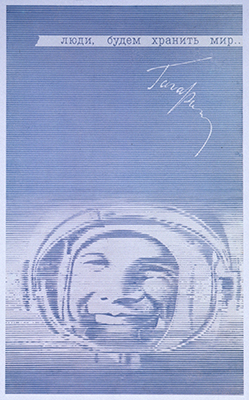- History
- Military

The Space Age opened in October 1957 when the Soviet Union’s Sputnik I became the first satellite to orbit the earth.
Launched during the International Geophysical Year, Sputnik I orbited earth every 96 minutes for 21 days, traveling more than 40 million miles as it transmitted a steady beep signal that was soon recorded and broadcast to American radio listeners. The satellite itself was visible to viewers in the United States during dawn and twilight, providing directly observable evidence that the United States—for the moment at least—was trailing its chief geopolitical rival in the emerging technology that would define the balance of power in an era of nuclear stand-off.
Aware of the Soviet Union’s progress on Sputnik from spy plane imagery, the Eisenhower Administration had been planning to launch a United States satellite. The failure of a United States Vanguard rocket in December 1957 heightened fears about the Soviet lead in space technology. But the United States had been developing rocket and satellite technology since the early 1950s, and the successful launch into orbit of the Explorer I satellite in January 1958 demonstrated that the country was prepared to take on the Soviet Union in space. The creation of the Advanced Research Projects Agency (ARPA) in February 1958 signaled to the American public and the Soviets that the United States was committed to regaining superiority in advanced technologies.
Space captured the American imagination, and while scientists and defense officials built the country’s space technologies, Hollywood launched an entertainment juggernaut that has lasted to this day, including the Star Wars movie franchise, myriad smaller programs like My Favorite Martian and The Jetsons, and Star Trek’s epic exploration of the final frontier. President Kennedy rallied the country around the new frontier with the Apollo program, and to this day—despite conceding some incremental “firsts” to the Soviet Union—the United States remains the only country to have developed the technologies and support systems required to land humans on the moon and return them safely to earth.
Space lost some of its appeal as moon landings became almost routine. Budget cuts at the National Aeronautics and Space Administration (NASA) eventually brought an end to the space shuttle program and the United States once again fell behind in the Space Race, depending on Russian rockets to launch American astronauts to the International Space Station.
Although space remained free of actual weapons during the Cold War, the strategic and military dimensions of the space domain never ceased, and in the past 12 to 18 months the outlines of a dangerous new chapter of the Space Race have emerged. The United States, Russia, China, France, and India are all moving forward with the development, testing, and in some cases, demonstration, of space-based weapons that can attack opponents’ space systems in orbit, attack targets on earth from space weapon platforms, or disable missiles travelling through space. In March, India tested an antisatellite weapon by destroying one of its own satellites, drawing little notice despite the protests that followed a similar Chinese test in 2007, and this summer France announced a new space force and intentions to launch satellites equipped with lasers. Russia, China, and the United States are developing, and reportedly deploying, hypersonic weapons that can skip along the edge of space before re-entering the earth’s atmosphere to strike targets on land or sea at up to five times the speed of sound, making them virtually impossible to intercept with current technology.
In a report made public earlier this year, the U.S. Defense Intelligence Agency (DIA) reported how China and Russia are both developing military capabilities for space conflict, ranging from high-energy platforms such as lasers to new generations of ground-based anti-satellite missiles. Both countries reorganized their militaries in 2015, emphasizing the importance of space operations. Both are developing jamming and cyberspace capabilities, directed energy weapons, on-orbit capabilities, and ground-based antisatellite missiles. Organizationally, both have developed robust and capable space services, including space-based intelligence, surveillance, and reconnaissance. Russia and China have also improved their space launch vehicles and satellite navigation constellations to provide military leaders with the ability to command and control their forces worldwide, while enabling them to monitor, track, and target U.S. and allied forces. The DIA says the Chinese and Russian space surveillance networks are capable of searching, tracking, and characterizing satellites in all earth orbits, posing a threat to space-based services across the military, commercial, and civil space sectors.
Recognizing that the new Space Race, if little-covered by the media, is clearly a military contest, the United States established the U.S. Space Command as a new combatant command, a move widely viewed as a precursor to standing up a Space Force as an independent sixth branch of the U.S. military. Congress and the Pentagon are debating the structure, funding, and staffing of the Space Force.
However the matter is resolved, the space agenda is already full. Commercial space companies in the U.S. and elsewhere are forging ahead with plans to build elaborate networks of communications satellites, human-occupied outposts on Mars or mining operations on asteroids. Boeing will conduct a test flight of its Starliner commercial crew vehicle in December, and SpaceX will perform an in-flight abort test of its commercial spacecraft, the Crew Dragon, in late November or early December. In the U.S., defense officials are ramping up efforts to compete in space, having requested $304 million in the 2020 budget for research into space-based lasers, particle beams, and other new forms of missile defense, aiming to test a particle-beam weapon in orbit in fiscal year 2023. Defensive measures are underway as well. In the past year, the U.S. Air Force launched its first two GPS III satellites, built by Lockheed Martin, which will enable a new military signal designed to reduce exposure to jamming.
This October also saw China assume leadership of the Communist space threat to the United States and the West. A military parade to celebrate the 70th anniversary of the founding of Communist China showcased formidable new missile technology. China’s tech progress has spawned a sci-fi trilogy, Remembrance of Earth’s Past, in which two civilizations from distant planets compete to control the technological frontier. It has garnered a dedicated following among Chinese aerospace engineers and the mainstream reading public alike, and the author, Liu Cixin, has addressed engineers about how sci-fi can stimulate creative approaches to scientific challenges.
The central features of China’s October 1 parade were a vehicle-mounted hypersonic ballistic nuclear missile and an intercontinental ballistic missile that could reach the United States in 30 minutes. It took Sputnik I a full 96 minutes to orbit the earth and usher in the Space Age. It may be time for U.S. leaders to strengthen the country’s defenses on the Final Frontier.















